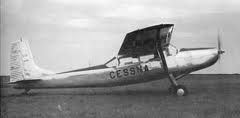Wingspan 14 m | ||
 | ||
The Cessna 308 was a prototype military light transport aircraft based on the successful Cessna 305 observation aircraft. Only one aircraft was completed and the project did not proceed further, due to a lack of orders.
Contents
Development
The Cessna 308 was conceived as an enlarged model 305 that would carry four people for the military light transport role and was developed in response to a US Army requirement.
The resulting design was first flown in July 1951. While the aircraft was based on the model 305, it incorporated a four-place cabin similar to the then current production Cessna 170. The prototype was powered by a Lycoming GSO-580 geared, supercharged, eight-cylinder engine, producing 375 hp (280 kW). The prototype featured a 47 ft (14 m) wingspan, taildragger landing gear and a 4,200 lb (1,905 kg) gross take-off weight. In trials the 308 proved capable of operating from rough fields carrying a 1,000 lb (454 kg) payload, with a range of 695 nmi (1,287 km).
The US Army chose the de Havilland Canada DHC-2 Beaver for the intended light transport role putting it into service as the L-20A. As a result, development of the Cessna 308 was not continued beyond the completion of a single prototype.
Specifications (Cessna 308 prototype)
Data from The Cessnas that got away
General characteristics
Performance
